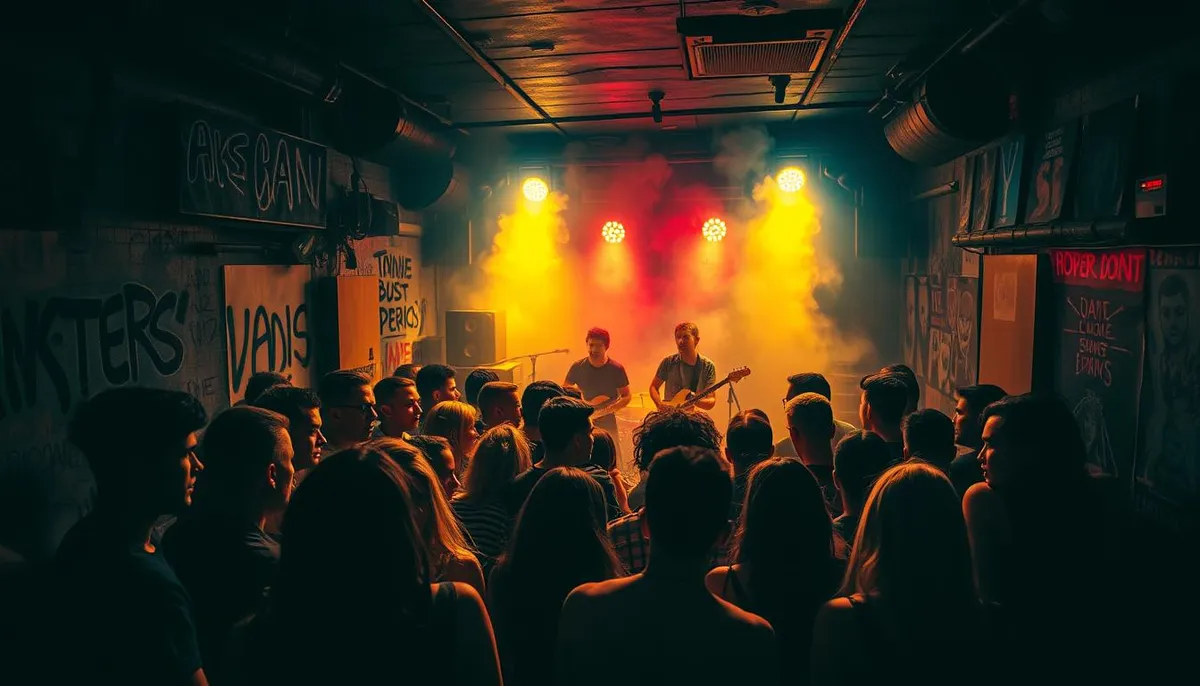The notion of counter-culture is a complex phenomenon that emerged in the 1960s, primarily in the United States. This cultural movement developed in opposition to the dominant values of society.
The term “counter-culture” has been used to describe various dissenting practices. Over the years, its meaning has evolved, reflecting changes in society and social contexts.

In this article, we will explore the concept of “ counter culture” and examine its meaning in our current world. We will also provide an introduction to general culture, analyzing the main characteristics that define a counter-culture and distinguishing it from other cultural movements.
Definition and Origins of Counter Culture
Counter-culture is a movement that sought to propose an alternative to established culture. This phenomenon took root in the 1960s, a period marked by profound social and cultural upheavals.
Etymology and Early Uses of the Term
The term “counter-culture” was first used to describe the dissenting movements emerging within society. These were groups that rejected dominant values and norms, seeking to create a new culture that was freer and more egalitarian.
The use of the term became widespread with the publication of critical works on modern society. Theodore Roszak's work, “The Making of a Counter Culture,” played a key role in theorizing this concept.
Theodore Roszak and the Birth of the Concept
Theodore Roszak is a central figure in the theorization and popularization of the concept of counter-culture. His foundational work, “The Making of a Counter Culture,” analyzes the critique of technocracy and its impact on youth.
- Roszak presents counter-culture as a response to the alienation of modern man in a society dominated by technology.
- He identifies youth as the main vector of social and cultural change.
- Roszak explores the ideas developed by counter-culture theorists regarding the necessity of placing human experience at the heart of society.
For Roszak, technocracy dehumanizes and dispossesses man, and counter-culture offers a comprehensive alternative that could restore humanity to the center of society.
Counter Culture: Fundamental Principles
The fundamental principles of counter-culture revolve around an opposition to dominant culture. This opposition manifests in various ways, notably through the rejection of traditional societal values and structures.
Opposition to Dominant Culture and Technocracy
Counter-culture is characterized by its fierce opposition to dominant culture and technocracy. It questions established authority and norms, seeking to create alternatives to existing systems. This opposition is not only political but also cultural, encompassing arts, literature, and lifestyles.
Technocracy, perceived as a form of governance where decisions are made by technical experts, is particularly contested. Counter-culturists view this form of power as a threat to individual freedom and creativity.

Difference Between Counter Culture and Avant-Garde
It is crucial to distinguish counter-culture from the avant-garde. While the avant-garde often presents a clear program and publishes manifestos, counter-culture is a more diffuse and less organized phenomenon. The avant-garde seeks to innovate in artistic and literary forms, sometimes breaking with conventions, but it does not necessarily challenge fundamental societal structures.
Counter-culture, on the other hand, is centered on a profound questioning of societal values and norms. It favors a spontaneous and diffuse approach, manifesting through various social movements and artistic expressions.
In summary, counter-culture is distinguished from the avant-garde by its less structured nature and its goal of challenging the foundations of society, rather than simply innovating in artistic or literary fields.
Historical Context and Emergence
Counter-culture emerged in a particular historical context, marked by major social and political upheavals. This period was characterized by a questioning of traditional values and the emergence of new forms of cultural expression.
The United States of the 1960s as the Cradle
The United States of the 1960s was the cradle of counter-culture. This decade was marked by significant social movements, such as the civil rights movement and the anti-war movement. Young Americans, in particular, began to question the authority and values of their parents, seeking to create a more egalitarian and freer society.
Alternative media and artistic movements emerged, reflecting this new culture. Music, in particular, played a key role in expressing counter-culture, with genres such as rock and folk becoming symbols of rebellion against dominant culture.
International Expansion and Arrival in France
American counter-culture spread internationally over the years, notably in Western Europe. In France, this influence was particularly notable after May 68, when students and workers revolted against the government and established social structures.
Media and institutions such as the magazine Actuel, the daily Libération, and Éditions Alternatives played a crucial role in disseminating counter-cultural ideas in France. French counter-culture thus took shape, integrating elements of American culture while developing its own specificities.
The period following May 68 saw the emergence of various counter-cultural expressions in France, ranging from free radios to independent music labels. These movements contributed to shaping an alternative cultural identity, reflecting the aspirations and values of the French youth of the time.
Expressions and Manifestations of Counter Culture
The expressions of counter-culture have been numerous, ranging from alternative communities to iconic music festivals. This diversity reflects the complexity and richness of the counter-cultural movement.
Social Movements and Alternative Communities
Social movements played a crucial role in counter-culture, with alternative communities establishing themselves to live according to principles different from those of dominant society. These communities experimented with new forms of collective living, emphasizing cooperation, mutuality, and various marital customs.
Artistic Expressions and Alternative Media
Counter-culture also found its expression in various forms of art and alternative media. Artists used these channels to disseminate dissenting messages and propose new visions of the world. This included the creation of underground magazines, independent films, and experimental music.
Music and Iconic Festivals
Music, particularly rock, has been a central element of counter-culture. Festivals like Woodstock Music & Art Fair (1969) and the Altamont Speedway Free Festival (1969) marked the peak and decline of this movement. The assassination of John Lennon by Mark Chapman on December 8, 1980, symbolizes the end of this idealistic period.
Here are some key points that illustrate the importance of music and festivals in counter-culture:
- The central role of music, particularly rock, in the expression and dissemination of counter-culture.
- Iconic major festivals like Woodstock that crystallized the counter-cultural spirit.
- The way these musical gatherings became symbols and key moments of counter-culture.
- The tragic end of some of these events symbolized the gradual decline of the original counter-culture.
- Examples of musicians and bands that embodied counter-cultural values and aesthetics.

Intellectual Figures and Major Influences
The 1960s and 1970s saw the emergence of prominent personalities who gave a voice and face to counter-culture. These figures played a crucial role in defining and disseminating counter-cultural ideals.
Thinkers and Theorists of Counter Culture
Thinkers like Theodore Roszak theorized counter-culture, defining it as a movement that opposes technocracy and dominant culture. Others, such as Herbert Marcuse, influenced counter-cultural thought with their writings on individual and collective liberation.
Iconic Artists and Activists
Artists and activists have been the vanguard of counter-culture, embodying its values and aspirations. John Lennon, for example, was one of the last great figures associated with this movement, following the tragic deaths of Brian Jones, Jimi Hendrix, Janis Joplin, Jim Morrison, and Phil Ochs. These personalities navigated between different groups and movements, maintaining their uniqueness while sharing the hopes of their generation.
The tragic end of some of these figures symbolically marked the decline of the original counter-culture. However, their legacy continues to influence contemporary social and cultural movements.
Critiques and Limits of the Concept of Counter Culture
Counter-culture, while being a revolutionary movement, has faced numerous critiques. Despite its hopes for radical change, counter-culture has encountered several challenges, including the cultural belonging conflict that has questioned its effectiveness and coherence.
Co-optation and Banality of Dissenting Movements
One of the main issues of counter-culture has been its co-optation by the dominant system. Dissenting movements have often been trivialized, thus losing their initial impact. This has led to a loss of their original meaning and an integration into mainstream culture.
Debates on Effectiveness and Ideological Coherence
Counter-culture has also been criticized for its lack of ideological coherence. The different currents within counter-culture have sometimes struggled to maintain a clear guiding line, leading to debates about its real effectiveness. Furthermore, the transgression of social codes has sometimes been confused with genuine political action, raising questions about the actual scope of the movement.
Conclusion: Legacy and Contemporary Relevance
Despite its partial co-optation, the spirit of counter-culture continues to inspire contemporary social and artistic movements. Counter-culture, born in the 60s, has durably transformed certain aspects of our culture, particularly in the fields of artistic creation and alternative press.
New forms of counter-culture are emerging in response to the technological and social changes of recent decades, demonstrating the relevance of counter-cultural ideas in the face of current challenges. Counter-culture has also redefined our relationship with tradition and cultural innovation, allowing us to rethink today’s and tomorrow’s dissenting movements.
Thus, the legacy of counter-culture remains vibrant, years after its emergence, still influencing our society.
RelatedRelated articles


